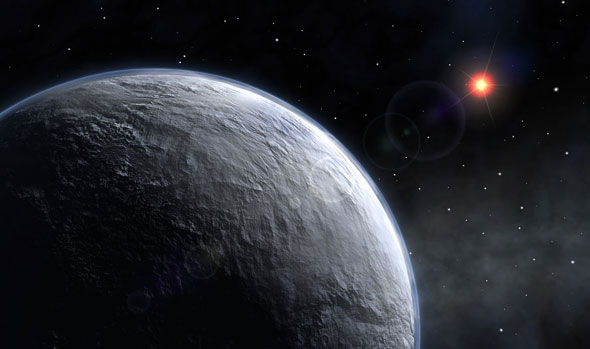|
It's the Astronomy Online non-Blog, or un-Blog.
Everyone has a blog now and since I am no follower of trends, I decided to merge the blog with the website. And I don't want to neglect the website in favor of posting on the blog.
These are the pages that were on the blog of old:
- Home
- Archive (Index of Pages)
- Me
- Current Trends
- Links
- Soho Live
Links:
Google Maps - Mars
Google Maps - Moon
HiRISE
HiRISE - MRO Imaging
Mac Singularity
Meade4M
Slackerpedia Galactica
Software for the Mac
Starry Night Online
Venus Maps
More Favorites:


































Thank you for visiting!
|
|
 |
|
Rocky Planet Discovered by Microlensing:
Artist impression of a rocky body orbiting a Red Dwarf star.

Image Credit
The Project OGLE (Optical Gravitational Lensing Experiment) discovered an almost 6 Earth-mass planet surrounding a star 20,000 light years towards the center of our galaxy. This star is only 1/5 the mass of our Sun. As for the planet, it is the smallest exoplanet discovered to date - which beat out the 7.5 Earth-mass planet orbiting Gliese 876. The name of this planet: OGLE-2005-BLG-390Lb. The planet orbits its host at a distance of 3 A.U.'s - or three times the Earth's orbit.
Given the size of the star and the distance of this planet, it is doubtful to be Earth-like. In fact, the temperature is estimated to be about -354 degree F. However, it has been determined this body is a rocky, icy body - either a planetroid in itself or a "failed Jupiter." This means the planet either failed to develop the gas envelope of a Jupiter-like body, or was blown away in the systems early evolution.
Microlensing is a technique that is best used to detect smaller bodies while passing near, or transiting a distant star. Momentary spikes of light are detected as the mass of the planet momentarily affect the light from the star.
It is hopeful that the OGLE project, which uses a microlensing technique for planetary detection, will detect Earth-like bodies - according to the NASA PlanetQuest website. However, it is my opinion that detection by the transit method - that is a photometrically visible drop in stellar brightness due to a transiting planet - will offer the best chance for detecting Earth-like worlds. This technique will allow Astronomers to gather spectroscopic data of the star and the planet which will allow for a possible detection of an atmosphere - something the microlensing technique cannot do. It should be made clear that an Earth-like planet suggests an atmosphere while an Earth-mass planet suggests a rocky body that is similar in mass to our Earth.
More information on OGLE and Exoplanets can be found at my website's Exoplanet Section, NASA's PlanetQuest, the OGLE homepage and the Exoplanet homepage.
Next Post | Previous Post | Back to Top
|
|

